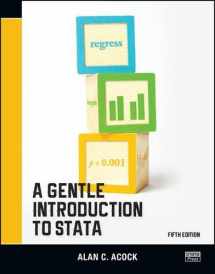
A Gentle Introduction to Stata, Fifth Edition
Book details
Summary
Description
Alan C. Acock's A Gentle Introduction to Stata, Fifth Edition,
is aimed at new Stata users who want to become proficient in Stata.
After reading this introductory text, new users will be able not only
to use Stata well but also to learn new aspects of Stata.
Acock assumes that the user is not familiar with any statistical
software. This assumption of a blank slate is central to the structure
and contents of the book. Acock starts with the basics; for example,
the portion of the book that deals with data management begins with a
careful and detailed example of turning survey data on paper into a
Stata-ready dataset on the computer. When explaining how to go about
basic exploratory statistical procedures, Acock includes notes that
will help the reader develop good work habits. This mixture of
explaining good Stata habits and good statistical habits continues
throughout the book.
Acock is quite careful to teach the reader all aspects of using Stata.
He covers data management, good work habits (including the use of
basic do-files), basic exploratory statistics (including graphical
displays), and analyses using the standard array of basic statistical
tools (correlation, linear and logistic regression, and parametric and
nonparametric tests of location and dispersion). He also successfully
introduces some more advanced topics such as multiple imputation and
structural equation modeling in a very approachable manner. Acock
teaches Stata commands by using the menus and dialog boxes while still
stressing the value of do-files. In this way, he ensures that all
types of users can build good work habits. Each chapter has exercises
that the motivated reader can use to reinforce the material.
The tone of the book is friendly and conversational without ever being
glib or condescending. Important asides and notes about terminology
are set off in boxes, which makes the text easy to read without any
convoluted twists or forward-referencing. Rather than splitting topics
by their Stata implementation, Acock arranges the topics as they would
appear in a basic statistics textbook; graphics and postestimation are
woven into the material in a natural fashion. Real datasets, such as
the General Social Surveys from 2002 and 2006, are used
throughout the book.
The focus of the book is especially helpful for those in the
behavioral and social sciences because the presentation of basic
statistical modeling is supplemented with discussions of effect sizes
and standardized coefficients. Various selection criteria, such as
semipartial correlations, are discussed for model selection. Acock
also covers a variety of commands available for evaluating reliability
and validity of measurements.
The fifth edition of the book includes two new chapters that cover
multilevel modeling and item response theory (IRT) models. The
multilevel modeling chapter demonstrates how to fit linear multilevel
models using the mixed command. Acock discusses models with
both random intercepts and random coefficients, and he provides a
variety of examples that apply these models to longitudinal data. The
IRT chapter introduces the use of IRT models for evaluating a set of
items designed to measure a specific trait such as an attitude, value,
or a belief. Acock shows how to use the irt suite of commands,
which are new in Stata 14, to fit IRT models and to graph the results.
In addition, he presents a measure of reliability that can be computed
when using IRT.


We would LOVE it if you could help us and other readers by reviewing the book
Book review



